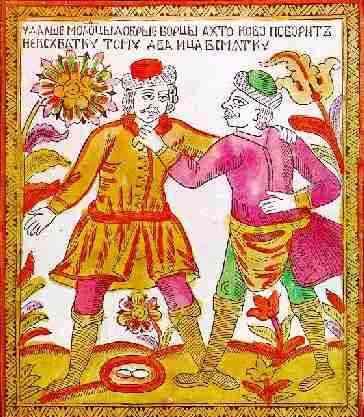
EVERYDAY LIFE (GENRE) LUBOK
Since the lubok was primarily an urban phenomenon, at first the prints belonging to this category were snapshots and vignettes from the city's streets, homes, or taverns. Only in the middle of the ninetenth century, influenced by folk songs, did images of village life flood the lubok. The earliest prints started coming out concurrently with the satirical lubok, soon after the religious images, and remained the most varied and popular of all the prints produced in Russia. Accompanied by rhymed and often ribald inscriptions, these lubki addressed all possible facets of social interaction. The Husband Weaves Bast Shoes With Skill, the Wife Spins Yarn With a Will shows a couple working by candlelight to get rich.
The Fellows Derring-Do and Good Fighters Too is just an illustration of a popular "open" wrestling match in which the winner gets a prize: two soft-boiled eggs. Such matches often took place during the celebrations of Maslenitsa (Shrovetide) and Semik.
Please, Be Gone From Me, is a very funny scene galante because the "polite" conversation between flirting characters is peppered with crude expressions. Give Me Back My Buckets is also concerned with mischievous flirtation. Ah, My Black-Eyed Miss presents a brief dialogue between a man and a woman, during which he asks for a kiss which will bring him joy, and she is ready to "hand" herself to him if he makes her his true love.
An Old Custom described what was expected of a good hostess during dinner, while the Register of Beauty Marks aided in interpreting the messages indicated by particular placement of artificial beauty marks which were in great vogue in the middle of the eighteen century. 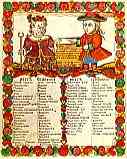 The Register of Colors and Beauty Marks, perhaps based on Nikolai Kurganov's Manual of Letter Writing, expands the topic by adding explanations of the symbolic meanings of colors. The print The Moscow Mead and Picture Vendors presents two popular characters from city streets.
The Register of Colors and Beauty Marks, perhaps based on Nikolai Kurganov's Manual of Letter Writing, expands the topic by adding explanations of the symbolic meanings of colors. The print The Moscow Mead and Picture Vendors presents two popular characters from city streets. 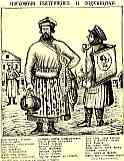 The Peepshow (according to the picture's inscription, The World Cosmorama) shows the amusement booth, several viewers glued to three little peepholes, and the booth master describing what the audience can see. Interestingly, the last two prints have a common element. In the former, the picture seller is carrying an advertising board with the portrait of Julia Postrana, the famous bearded lady who visited Russia, and in the latter, she is mentioned among the other subjects of the show. Two pictures from A Cut-Out ABC show two peddlers selling children's toys. Each seller's wares begin with a name of a certain letter; for instance, the letter "N" stands for "New Pictures."
The Peepshow (according to the picture's inscription, The World Cosmorama) shows the amusement booth, several viewers glued to three little peepholes, and the booth master describing what the audience can see. Interestingly, the last two prints have a common element. In the former, the picture seller is carrying an advertising board with the portrait of Julia Postrana, the famous bearded lady who visited Russia, and in the latter, she is mentioned among the other subjects of the show. Two pictures from A Cut-Out ABC show two peddlers selling children's toys. Each seller's wares begin with a name of a certain letter; for instance, the letter "N" stands for "New Pictures."
Around the middle of the nineteenth century, poems and songs became an important source of inspiration for the lubok artists. The works were selected either because of their popularity among the people or for the particular message which fit the printer's interests or public's demand. Some of the messages are serious and deal with unhappy love, parting, or longing for the loved one, but the others are joyous or funny; sometimes they assume the role of a moral guide and a critic of societal evils. 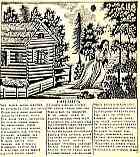 As a rule, the prints include the illustration and the text (full or abbreviated) of the song or the poem. Alexander Pushkin's 1814 poem Romance, about a girl who has to abandon her out-of-wedlock child, was turned into a folk-song and from 1832 appeared in popular prints. Another poem written in 1814, Konstantin Batiushkov's The Parting, was also included in song books and from there found its way into the lubok
As a rule, the prints include the illustration and the text (full or abbreviated) of the song or the poem. Alexander Pushkin's 1814 poem Romance, about a girl who has to abandon her out-of-wedlock child, was turned into a folk-song and from 1832 appeared in popular prints. Another poem written in 1814, Konstantin Batiushkov's The Parting, was also included in song books and from there found its way into the lubok 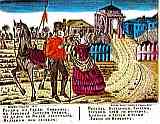 Hussar, Upon His Sabre Leaning. Picture subjects were also inspired by Aleksei Kol'tsov's poems, for instance The Ploughman's Song (1831), which praised the peasant's hard work, and Why Are You Sleeping, Peasant?, written in 1839 to condemn peasants' idleness and laziness.
Hussar, Upon His Sabre Leaning. Picture subjects were also inspired by Aleksei Kol'tsov's poems, for instance The Ploughman's Song (1831), which praised the peasant's hard work, and Why Are You Sleeping, Peasant?, written in 1839 to condemn peasants' idleness and laziness.
The late nineteenth-century printers frequently used poems written by less famous authors and found a rich source of material in folk songs. In Do Not Curse Me, My Dear, written by A. Razorenov, a girl confesses her great love for a young man to her mother. The song In the Evening A Fair Maiden, composed by N. Ibragimov in 1815 but incorporated into the song collections only in the 1850s, is about a girl who prefers a poor boy she truly loves to wealthy suitors. 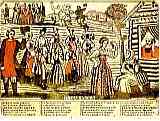 Don't Wake Up the Young Maiden, attributed to the early nineteenth century poet Vasili Kugushev, tells a story of a cowherd who plays his flute so well that a beautiful girl invites him to dance with her. Oblivious to everything but the girl, after an hour of dancing the cowherd loses a cow, and after another hour, half of his herd.
Don't Wake Up the Young Maiden, attributed to the early nineteenth century poet Vasili Kugushev, tells a story of a cowherd who plays his flute so well that a beautiful girl invites him to dance with her. Oblivious to everything but the girl, after an hour of dancing the cowherd loses a cow, and after another hour, half of his herd. 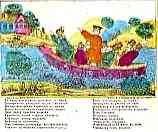 Down Along the Mother Volga, a popular Russian folk song, perhaps written by Ivan Osipov, a robber known as Vanka Kain, relates how, during the storm on the Volga, the boat full of young men takes shelter at the home of the pretty Katerina. Katenka Was Famous in the Entire Village for Her Beauty, in just six rhymed lines tells about beautiful Katenka who is not only courted by all the young men of the village, but also causes many marital quarrels between jealous wives and their husbands. C'mon Geese, C'mon Swans, It's Time to Go Home describes a meeting between a girl and a boy who makes advances to her. In a flirtatious and teasing manner, the girl explains that her mother will notice her flushed face and make an inevitable conclusion that her daughter was drinking beer, young wine, or cherry vodka. In the love-at-first-sight song The Lads Rode from Novgorod, a young man from Novgorod meets the pretty Akulina and declares his wish to marry her. In the Field Stood a Young Limetree introduces us to the Semik
celebrations and the custom of wreath weaving and finding out about the future husband. Ah, How Bright Is the Sky is a mournful story of a young man who has just been informed by his beloved that she has had to marry another. The Soldier's Farewell, like Batiushkov's poem, is concerned with a soldier's departure for war; asking his wife to be faithful "to the grave," this soldier promises to fight bravely to the end and to die with honor and glory. Interestingly, his horse, described in the first line of the song as "raven-black," in the print appears white. What a Noise They Are Making Outside is a comic song about village women who cannot find a better way to share a sarafan but by tearing it into pieces.
Down Along the Mother Volga, a popular Russian folk song, perhaps written by Ivan Osipov, a robber known as Vanka Kain, relates how, during the storm on the Volga, the boat full of young men takes shelter at the home of the pretty Katerina. Katenka Was Famous in the Entire Village for Her Beauty, in just six rhymed lines tells about beautiful Katenka who is not only courted by all the young men of the village, but also causes many marital quarrels between jealous wives and their husbands. C'mon Geese, C'mon Swans, It's Time to Go Home describes a meeting between a girl and a boy who makes advances to her. In a flirtatious and teasing manner, the girl explains that her mother will notice her flushed face and make an inevitable conclusion that her daughter was drinking beer, young wine, or cherry vodka. In the love-at-first-sight song The Lads Rode from Novgorod, a young man from Novgorod meets the pretty Akulina and declares his wish to marry her. In the Field Stood a Young Limetree introduces us to the Semik
celebrations and the custom of wreath weaving and finding out about the future husband. Ah, How Bright Is the Sky is a mournful story of a young man who has just been informed by his beloved that she has had to marry another. The Soldier's Farewell, like Batiushkov's poem, is concerned with a soldier's departure for war; asking his wife to be faithful "to the grave," this soldier promises to fight bravely to the end and to die with honor and glory. Interestingly, his horse, described in the first line of the song as "raven-black," in the print appears white. What a Noise They Are Making Outside is a comic song about village women who cannot find a better way to share a sarafan but by tearing it into pieces.